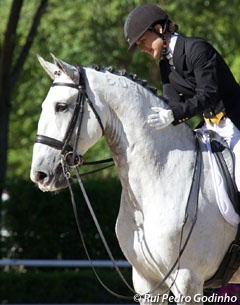
Finding relaxation in a position of strength is something my Pilates' instructor said to me recently. The key to most top level sports is training the body to relax in a position of strength, or endurance, or speed. Dressage therefore can be defined as just that: finding relaxation in a position that requires strength, both in terms of horse, and rider.
Think about it: The horse must be strong enough to perform the exercise, but be able to relax within it. A rider must be strong enough to hold their posture, their seat, their legs in place, strong enough to position the horse, to provide the necessary pressure for the aids, but to be able to relax within that position of strength.
It seems so easy, find your position, then relax. But in terms of both horse and rider this concept is extremely difficult to achieve. Why? Because both horse and rider often fall too far on either side of the relaxation/strength spectrum. A rider will either use too much force (strength) without the necessary relaxation, and produce a horse that is tense, and being moved around the arena by the use of harsh aids, and strong hands. Or the rider will be too relaxed in the saddle, will seem to flop about with the horse, without being able to let the horse balance, because their own weight is being distributed unevenly and without any correct posture or balance themselves.
In terms of the horse, a horse is often either too strong, leaning on the hand, and has not learned the value of strength and relaxation in correct posture to establish self-carriage and balance. Alternatively a horse may be too relaxed, and thus not have the strength to carry himself, and will therefore rely on the physical effort of his rider to sort of drive him around the arena.
So how do we find the right balance between strength and relaxation? How do we find that “relaxation from a strength pPosition” that is so hard to find, yet is at the heart of all dressage training, from young horse to Grand Prix?
First in terms of the rider; this comes down to body awareness. Often as riders we have muscles that overactivate. This means that when we want to do a simple movement, our muscles go all in and use more than the necessary strength required. This also means that when we think we have relaxed a muscle, we actually have only relaxed it partially.
If you don’t believe me sit down with your feet together and your knees out to the side. Relax your adductors. Then, think about whether they are really relaxed and try to really let them go. Typically you will have one of those, oh, moments, where you realised that your idea of relaxed, and actually fully relaxed, are two different things. Once we can learn how to fully relax, often yoga or pilates helps a lot, we can learn how to hold and balance our own bodies evenly, and then relax maintaining that position of strength. Doing it on the horse is more difficult, and it takes patience and work, and thought, and help!
For the horse, Nuno Oliveira used to say that “the horse is not a machine, but a living being. Therefore, we must know what dose of relaxation and degree of vigor that we must employ with each horse.” What he meant of course is that the dose of strength versus relaxation required on one horse, will be vastly different to that required on another.
We must learn to set the horse up for the movement, and then let him do the work, allowing him to relax into it, move alone, and build the strength to carry out said exercise with ease. He will then learn to not only relax physically in the exercise but also mentally, because his rider is not banging and crashing about with every stride.
Finding relaxation from a position of strength, poise and balance, is about patience, and feel, and adjustment. All the elements of dressage that we must incorporate into every training, until things become effortless.
“The criterium of a good rider is a rider that we cease to notice, and we only watch the horse," said Nuno Oliveira.
by Sarah Warne - Photo © Rui Pedro Godinho